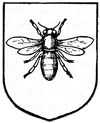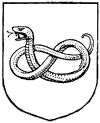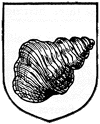| ND Home > ND Libraries > Spec. Coll. > Digital > Heraldry > Blazoning > Charges > Fish, etc. |
 |
|
Fish, insects, and reptiles, though not as common, still have their place in heraldry. Unlike modern classifications of fish, heraldic charges considered to be "fish" include dolphins, wales, and other sea creatures. Like birds and beasts, the positioning of fish takes on different forms. The symbol of the bee is probably the most widely used insect in heraldic charges, considered to represent industry. Other insects in use include ants, butterflies, and crickets. Reptiles other than serpents are rare in heraldic charges, with the snake being the most prominent. It's position differs depending on the charge. Other reptiles used in heraldry include toads or frogs and lizards.
Fish &Other Sea Charges
|
heraldic dolphin |
heraldic dolphin hauriant |
An heraldic dolphin will always appear enbowed (i.e., curved). If the dolphin is neither naiant nor hauriant, it is simply described as embowed |
whelk shell |
escallop |
|
|
|
|
|
|
|
whale |
salmon |
herring |
trout |
|
|
eel |
lobster |
crab |
shrimp |
|
Insects
| bee volant |
A bee might also be found; walking in profile with its wings elevated; perched upon a thistle. The bee appears more often in the crest than as a part of the armorial. |
grasshopper | cricket | ants |
 |
||||
| butterflies | spider | |||
Reptiles
| serpent nowed |
A serpent may
also be found: The arms of doctors or physicians may include the rod of Æsculapius (i.e., one or two sepernts twined around a staff). |
toad or frog | lizard | |
 |
||||

 |
|||
|
|
Copyright © 2005
| Dept. of Special Collections University of Notre Dame 102 Hesburgh Library Notre Dame, Indiana 46556 |
Telephone: 574-631-0290 Fax: 574-631-6308 E-mail the Department |
Page content last modified
05 May 2000 |



